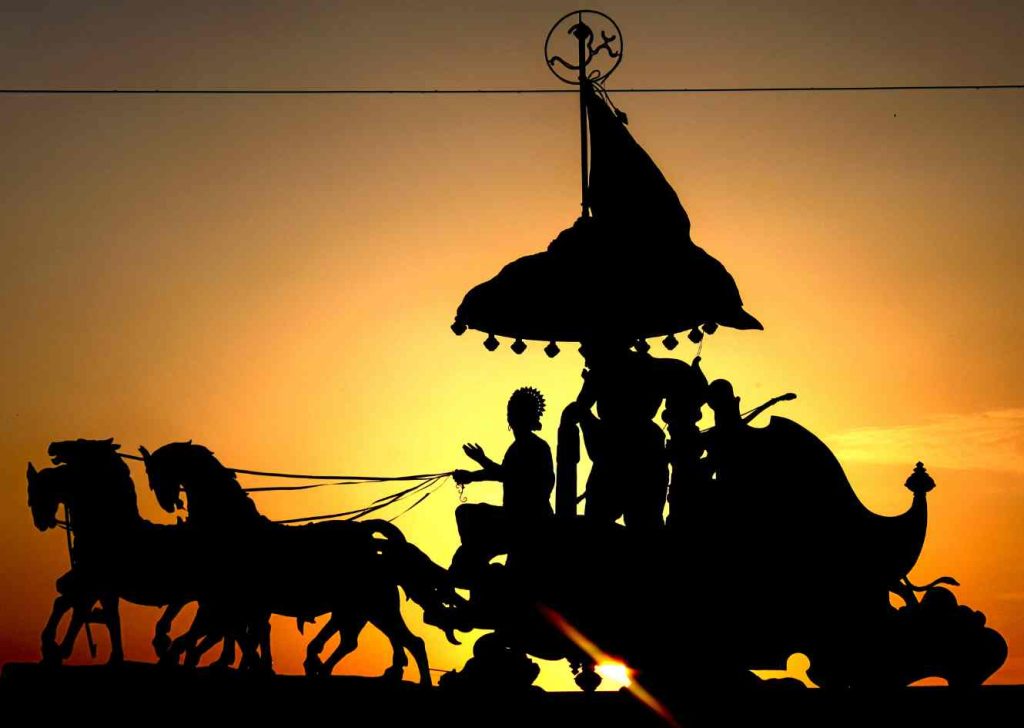The Chariot in the Mahabharata Is You

The chariot used by Arjun in the Mahabharata is a representative of life itself in many ways. In Hindu philosophy, the analogy of the body being likened to a chariot is a profound metaphor used to convey deep spiritual insights and the nature of human existence. This analogy is most prominent in ancient Hindu scriptures like the Upanishads and the Bhagavad Gita. It offers a comprehensive understanding of the relationship between the physical body, the senses, the mind, and the eternal soul (atman).
Krishna’s role as a charioteer in the Mahabharata carries profound spiritual symbolism, representing essential aspects of the human spiritual journey. In this context, the chariot, horses, and charioteer are not merely elements of a battlefield but symbolic representations of deeper spiritual truths.
The Chariot Analogy:
According to this analogy, the human body is compared to a chariot, the senses to the horses that pull the chariot, the mind to the reins that control the horses, and the soul (atman) to the passenger seated within the chariot.
1. The Chariot (Body):
The chariot in which Arjuna stands represents the physical body. In Hindu philosophy, the body is often likened to a chariot, and the soul (atman) is the passenger. Just as the chariot moves through the battlefield, the soul traverses the journey of life within the physical body. The symbolism emphasizes the impermanent and transient nature of the body. It reminds us of the importance of seeking something beyond the material realm.
Just as a chariot requires proper care and maintenance to function optimally, the body also demands proper nourishment, exercise, and care to remain healthy and fit.
2. The Horses (Senses):
The horses that pull the chariot represent the five senses – sight, hearing, taste, smell, and touch. These senses interact with the external world, gathering information and experiences that shape our perception of reality. Like spirited horses, the senses can be untamed; if not controlled, they may lead the chariot (body) astray.
Like spirited horses, our senses and mind can be untamed, constantly pulling our attention in different directions. Controlling these senses and the mind is a significant aspect of spiritual practice, leading to greater focus and inner peace. Krishna’s role as the charioteer signifies the need to harness and master these senses and the mind to achieve spiritual growth.
3. The Reins (Mind):
The reins that control the horses represent the mind, which guides and regulates the senses. The mind interprets sensory inputs, makes judgments, and initiates actions based on past conditioning and experiences. Depending on self-awareness and self-discipline, it can direct the senses toward virtuous or unvirtuous actions.
The mind plays a vital role in guiding the senses and making decisions. Thus, it is crucial to cultivate a calm and focused mind to make wise choices and direct actions toward the path of righteousness.
Just as a charioteer needs to control the horses with firm reins, individuals are encouraged to discipline the mind and senses to lead a purposeful and virtuous life.
4. The Passenger (Atman – The Soul):
The most critical element of the analogy is the passenger seated within the chariot, which symbolizes the eternal soul (atman) residing within the physical body. The soul is considered a fragment of the universal consciousness (Brahman) and is beyond birth and death. It merely observes and experiences the journey through life, unaffected by the joys and sorrows experienced by the body-mind complex.
The soul faces various challenges and dilemmas in its journey, represented by the moral dilemma Arjuna faces before the war. Arjuna’s confusion and inner turmoil resonate with the human struggle to discern right and wrong, good and evil.

Krishna’s role as a charioteer in the Mahabharata is pregnant with spiritual symbolism. It encompasses the physical body as a chariot, the senses and mind as horses, and the soul (atman) as the passenger. Krishna, the charioteer, represents the divine consciousness guiding and supporting every individual soul in its spiritual journey. The Bhagavad Gita, delivered during this crucial moment, serves as a timeless guidebook for seekers. It offers profound spiritual wisdom and insights for leading a purposeful and fulfilling life.
As the passenger, you are separate from the body and the mind – things that we often identify ourselves with. As Sadhguru says, once you create a distance between you and your body and between you and your mind, that is the end of suffering.
The Mahabharata itself, with its intricate characters, diverse themes, and complex narrative, reflects the multifaceted nature of human life. As an analogy for life, it provides valuable insights into the human condition, our struggles and choices, and the quest for higher truths and self-realization. The epic’s timeless wisdom continues to inspire and guide individuals on their self-discovery and spiritual growth journey.
